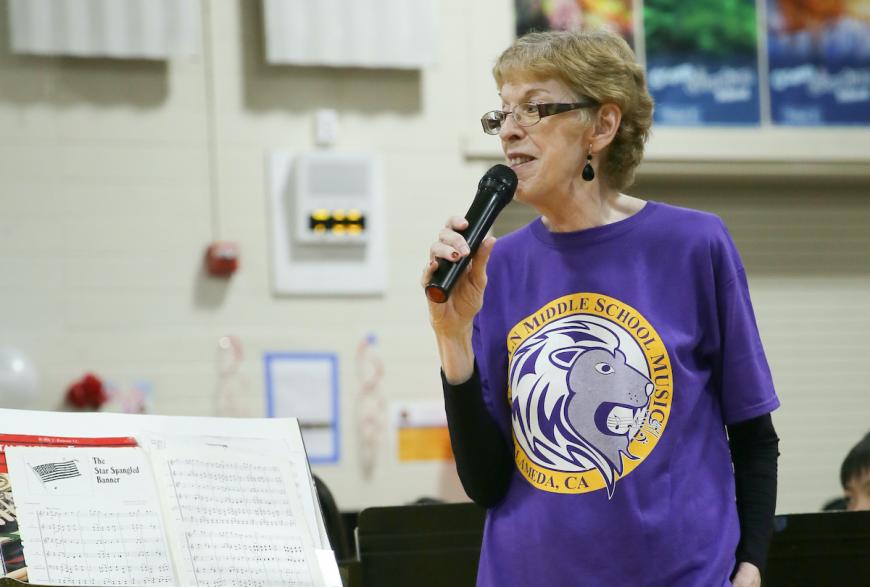
Talk to almost any professional classical musician about their early training and you will hear the story of a teacher. Maybe it’s special mentor who fired their passion, bolstered self-confidence, perhaps pushed, cajoled, enforced strict standards. A person who simply cared about their individual identity and their commitment to music. A person like Tyra Ingram Cable, music director for more than 20 years at Lincoln Middle School in Alameda. Amazingly, Cable has kept her music program going full steam during the pandemic, a time when many school music programs were sapped of energy.
Cable and her five siblings grew up in Sylacauga, Alabama. Her parents had no background in music. Her father was a salesman in the life-insurance industry; her mother was a teacher in a one-room schoolhouse in Alabama and, after the family moved to Florida when Cable was in eighth grade, earned a teaching degree and taught fourth- to sixth-grade students.
“In my home, I remember when I was young, I wanted to play the piano. My family couldn’t afford it. My sister got a job and helped us buy a piano. My first teacher charged us a dollar, and I’d run home and teach my younger siblings everything I’d learned,” Cable says in an interview. “I always wanted to be near music. It made me feel like I could express myself. It touched my soul to be involved in playing it. I felt it was my calling and I was good at it. It just rang with me and made me want everyone around me to feel the joy too.”
Cable is not only a teacher whose impact echoes through generations of Bay Area music students — some of whom went on to pursue professional careers, some not — she herself recalls a special teacher. When a band director brought a variety of instruments into her fifth-grade classroom, she was enthralled. After the move to a much larger school in Florida, she encountered in her preteen years a band director with a robust program and a natural instinct for leading young music students while providing solid structures for group exploration that encouraged and maintained individuality. “I developed close friends during middle school; a time that’s often a hard time. It built self-esteem, being part of a team,” she says.
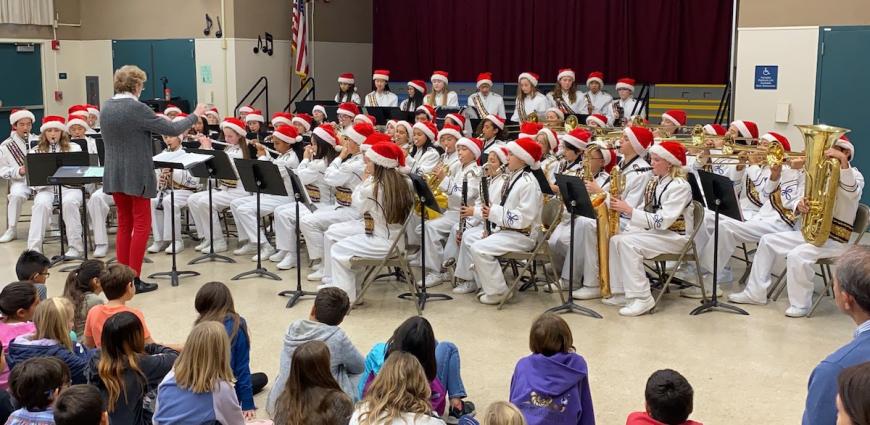
In the classroom today, Cable says music opportunities offered during preteen and early teen years allows students at a notably stressful developmental stage to express themselves, to understand the nature and rewards of hard work, to process emotions, to think and act as team members, to themselves become mentors to younger students. Lincoln Middle School music programs include concert band, marching band, flag team, jazz band, string orchestra, full symphonic orchestra, and small ensemble groups. The string orchestra was a first for the school district, and other middle- and high-schools in the area have followed her lead by offering that option. The bands under Cable’s direction annually win awards and are among the few select middle schools invited to participate in San Francisco’s Chinese New Year Parade. The advanced marching band for years has performed in the Disneyland Main Street Parade in Anaheim, visiting elementary schools during the annual trip and competing with other middle and high school bands.
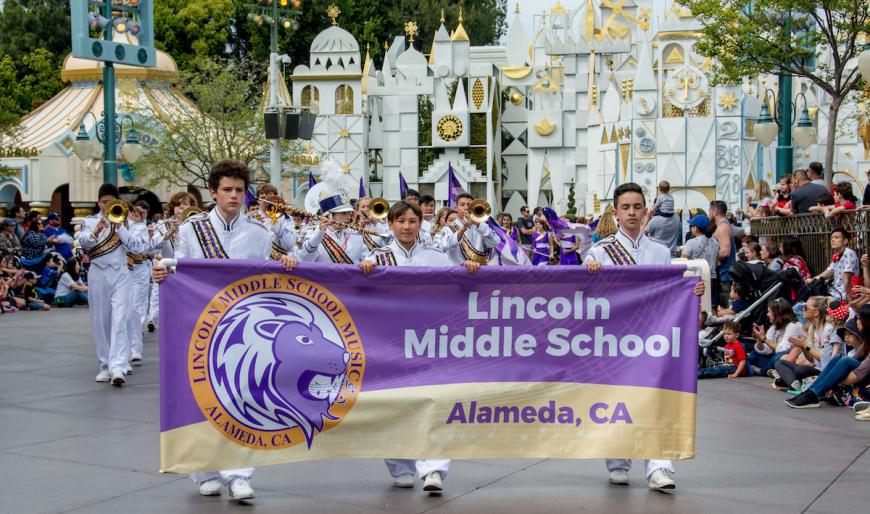
Student leadership opportunities and variety are woven into the programs, not pasted on as labels. “They learn in peer groups to help each other. Our marching band flag teams teach the younger students by putting eighth graders in pairs with sixth graders. Some students are in several groups and we rehearse after school. That’s part of the success of the program: The secret is that middle school students are so open and want to be challenged,” she says. “How does it help to have options? The different types of music help students to experience different emotions. For example, in marching band you’re moving and there’s a strong beat and you’re happy. In symphonic orchestra, they experience deep emotions through their instruments and by playing with others. I’ve seen kids crying in a concert when they hear the music they play together with their peers. The music comes to a high point they’ve never felt before.”
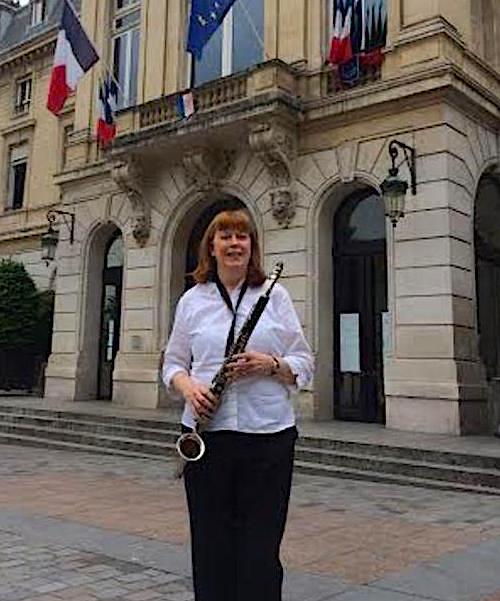
Tina O’Grady is the treasurer of Lincoln Music School Boosters whose children, Aidan and Clare, have participated in the program. “Tyra knows how to pack it in during that Anaheim trip. If the kids have idle time, she knows that’s when they might get in trouble, so she keeps them busy. They wake up at 6 a.m. and go to elementary schools that don’t have a lot of funding for music. They get more practice that way, but they also enjoy seeing these kids who look up to them like celebrities. It makes them feel confident and like that they’re doing something good,” she says.
By the time the young musicians get to Disneyland for the competitive activities, they’ve performed the program many times. “At the competition, it’s their chance to shine, to hear a live recording of the adjudicators’ comments, to gather with other groups who’ve competed. They get camaraderie,” O’Grady says. “For some, it’s the first time they’ve been away from their families for multiple days. It’s independence that they rise to; they come back standing taller. They know they can survive a challenge and being away from their families and be OK.”
O’Grady’s son during a pivotal time in his artistic growth wanted to delve deeper into music and began pursuing drum corps. In the tightly structured program and under Cable’s high-level expectations — stringent standards she says the students never fail to meet and often exceed — O’Grady says the entire family thrived. “Her program was unlike any other I’ve been involved in. It was joining generations; it was formulaic and like being a part of a new culture. It has been wonderful. I found my crew, my friends, as did my kids.”
Likewise, Music Booster President Lori Molero and her daughter, Mikayla, a trumpet player, appreciate that during the pandemic Cable mastered and then familiarized students with Smartmusic.com, a district-supplied digital program allowing musicians and instructors to meet up online and play together. “Even with the in-person events not happening, it hasn’t been hard to keep the enthusiasm,” says Molero. “Mrs. Cable found ways to bring the students together, making sure there were days when they could meet and stay engaged.” Participation in the program she says has impacted her daughter well beyond just lessons learned in a music class. “It’s a community builder. Mrs. Cable has taught my daughter how to work in groups. She has high expectations and holds students accountable. When Mikayla knows what to expect within structure, she can see results.”
Comments emailed from parents and past and current participants in the program give a profound collective illustration of how one teacher can transform many lives.
Mary Grace Basco’s twin children studied with Cable during their three years at Lincoln. Nathaniel Basco was first chair percussion from 2015–2018 and plans to study music in college. He says, “Mrs. Cable doesn’t just teach her students to read and play music; she teaches them to understand and appreciate it. She wants them to pursue music after graduation and hopes that music continues to influence their lives.” Graciella Basco, first chair trumpet during the same years, says, “Mrs. Cable definitely opens doors. We got experiences of a lifetime such as marching down Main Street (at Disneyland) and at the Chinese Lunar New Year Parade in San Francisco, Alameda’s Fourth of July Parade, the opening ceremony at the Oakland A’s game, and competing at California Music Educators Association. Not all music directors are this dedicated to making sure their students are having fun.”
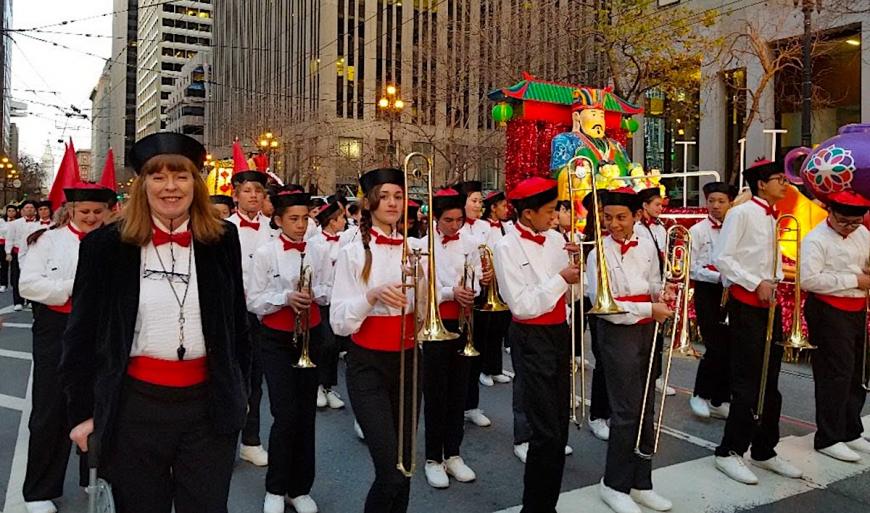
Cable says her teaching approach is a condensed form of her own enthusiasm. That excitement spills over into exploring a composer’s background and the social and historical significance of the music. Selecting works that have high emotion, strong dynamic contrast, and quick changing tempos, she says is key. As is choosing music that “speaks to” the students. “The purpose is variety: a Souza march, something serious and quiet, then music that conveys joy, happiness. I get Lady Gaga and Michael Jackson pieces, because the students relate to those and there’s audience appeal. If the audience likes it, the students get great joy and pride. I’m a fan of themed programs. Right before COVID-19 happened we were planning our dessert spring concert. The kids get custom T-shirts and we serve desserts; we were playing “Chariots of Fire,” “Ebony and Ivory,” Whitney Houston tunes, and others. The kids were involved in the selections.”
Asked what one experience most surprised her about teaching music remotely, she says it happened on Friday nights during the winter holiday season when, at 7 p.m., 50 or more students logged on to rehearse. “We’d play these songs and have fun. Hearing a track and playing with it has made them thrive in this difficult time.”
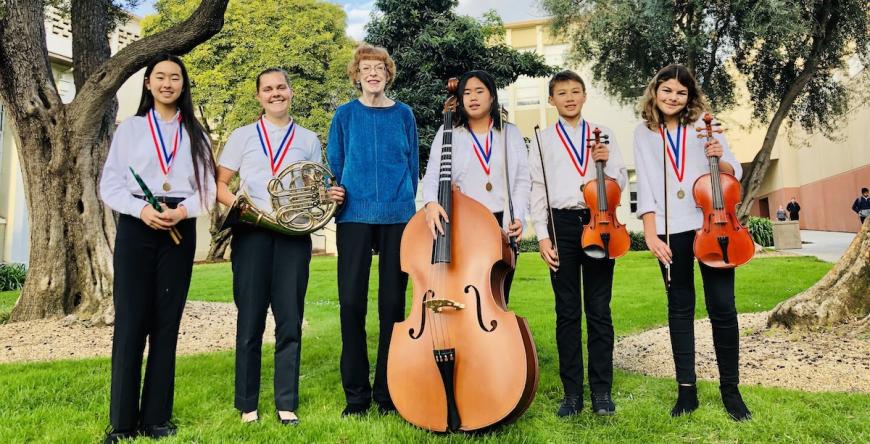
While directing the ambitious program prior to and during the pandemic, cancer treatments competed for Cable’s time and attention. “I’m still in chemo and hopefully having my last treatment next week. It’s been hard. I haven’t talked to the students about it in a long time because we’ve been online for a year. I had a reoccurrence on my liver and I’m responding to chemotherapy very well,” she says.
The lessons she has learned from students include, “If you present it to them with excitement, they go home and work to reach their high standard. I’ve never lowered my standards even though I do sometimes see them get discouraged. I tell them they can do it. Sure enough, they are amazing when they step forward. It’s a team and no one sits on the bench. Everyone has an important position on every ensemble. They have to work hard to make their group be good. They rise to any occasion. Sometimes it’s concert time and I’m doubting what it will sound like, and the kids will just blow you away.”
Resuming in-person classes during the past two weeks, Cable is again witnessing group cooperation and expression. “I look forward to everybody contributing, to being in the new band room after having had only five months in it before we were sent home. For sixth graders, because they’ve just barely started their instruments, they don’t know what it feels like to sit by another cello or violin player and hear the other part. It’s going to be joyful. In the smiles behind the masks — we play with special instrumental masks now — you can already see the joy through their eyes.”
You may wonder how many of Cable’s students become professional musicians. But it’s a number with no real importance. What’s significant is the number of young people who, along with their families, imbibe an appreciation for music and respect for its practitioners. What counts are the enduring, lifelong practices and principles established and passed on to generations by a legacy teacher.




